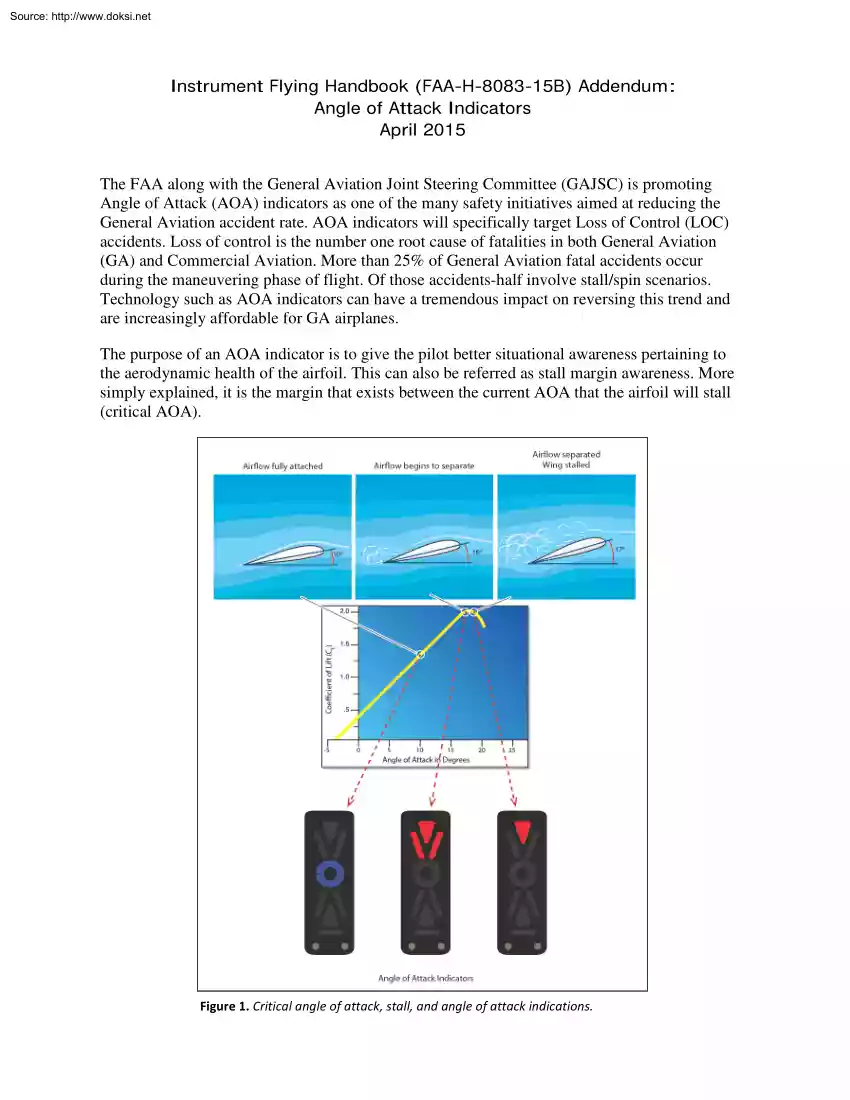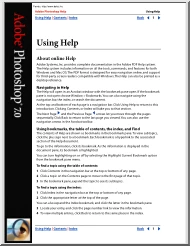A doksi online olvasásához kérlek jelentkezz be!

A doksi online olvasásához kérlek jelentkezz be!
Nincs még értékelés. Legyél Te az első!
Tartalmi kivonat
Source: http://www.doksinet Instrument Flying Handbook (FAA-H-8083-15B) Addendum: Angle of Attack Indicators April 2015 The FAA along with the General Aviation Joint Steering Committee (GAJSC) is promoting Angle of Attack (AOA) indicators as one of the many safety initiatives aimed at reducing the General Aviation accident rate. AOA indicators will specifically target Loss of Control (LOC) accidents. Loss of control is the number one root cause of fatalities in both General Aviation (GA) and Commercial Aviation. More than 25% of General Aviation fatal accidents occur during the maneuvering phase of flight. Of those accidents-half involve stall/spin scenarios Technology such as AOA indicators can have a tremendous impact on reversing this trend and are increasingly affordable for GA airplanes. The purpose of an AOA indicator is to give the pilot better situational awareness pertaining to the aerodynamic health of the airfoil. This can also be referred as stall margin awareness More
simply explained, it is the margin that exists between the current AOA that the airfoil will stall (critical AOA). Figure 1. Critical angle of attack, stall, and angle of attack indications Source: http://www.doksinet Angle of attack is taught to student pilots as theory in ground training. When beginning flight training, students will typically rely solely on airspeed and the published 1G stall speed to avoid stalls. This creates problems since this speed is only valid when the following conditions are met: • • • Unaccelerated flight (a 1G load factor) Coordinated flight (inclinometer) At one weight (typically maximum gross weight) Speed by itself is not a reliable parameter to avoid a stall. An airplane can stall at any speed Angle of attack is a better parameter to use to avoid a stall. For a given configuration, the airplane always stalls at the same angle of attack, referenced to as the critical angle AOA. This critical AOA does not change with: • • • • •
Weight Bank angle Temperature Density altitude Center of gravity An AOA indicator can have several benefits when installed in GA aircraft, not the least of which is increased situational awareness. Without an AOA indicator, the AOA is “invisible” to pilots. These devices measure several parameters simultaneously and determine the current angle of attack providing a visual image to the pilot of the current AOA along with representation of the proximity to the critical AOA. These devices can give a visual representation of the energy management state of the airplane. The energy state of an airplane is the balance between airspeed, altitude, drag, and thrust and represents how efficiently the airfoil is operating. With this increased situational awareness pertaining to the energy condition of the airplane, the pilot will have information that they need to aid in preventing an LOC scenario resulting from a stall/spin. Additionally, the less energy that is utilized to maintain flight
means greater overall efficiency of the airplane which is typically realized in fuel savings. This equates to a lower operating cost to the pilot. Figure 2. Lift/drag curve Instrument Flying Handbook Addendum: Angle of Attack Indicators April 2015 2 Source: http://www.doksinet Just as training is required for any system in an aircraft, AOA indicators have training considerations also. A more comprehensive understanding of AOA in general should be the goal of this training along with the specific operating characteristics and limitation of the installed AOA indicator. Ground and flight instructors should make every attempt to receive training from an instructor knowledgeable about AOA indicators prior to giving instruction pertaining to or in airplanes equipped with an AOA indicator. Pilot schools should incorporate training on AOA indicators in their syllabi whether their training aircraft are equipped with them or not. Installation of AOA indicators not required by type
certification in GA airplanes has recently been streamlined by the FAA. The FAA established policy in February 2014 pertaining to nonrequired AOA systems and how they may be installed as a minor alteration, depending upon their installation requirements and operational utilization, and the procedures to take for certification of these installations. For updated information on this, please reference the FAA webpage at http://www.faagov While AOA indicators provide a simple visual representation of the current AOA and its proximity to the critical AOA, they are not without their limitations. These limitations should be understood by operators of GA airplanes equipped with these devices. Like advanced automation such as autopilots and moving maps, the misunderstanding or misuse of the equipment can have disastrous results. Some items which may limit the effectiveness of an AOA indicator are listed below: • • • • • Calibration techniques Probes or vanes not being heated The type
of indicator itself Flap setting Wing Contamination Pilots of GA airplanes equipped with AOA indicators should contact the manufacturer for specific limitations applicable to that installation. Instrument Flying Handbook Addendum: Angle of Attack Indicators April 2015 3
simply explained, it is the margin that exists between the current AOA that the airfoil will stall (critical AOA). Figure 1. Critical angle of attack, stall, and angle of attack indications Source: http://www.doksinet Angle of attack is taught to student pilots as theory in ground training. When beginning flight training, students will typically rely solely on airspeed and the published 1G stall speed to avoid stalls. This creates problems since this speed is only valid when the following conditions are met: • • • Unaccelerated flight (a 1G load factor) Coordinated flight (inclinometer) At one weight (typically maximum gross weight) Speed by itself is not a reliable parameter to avoid a stall. An airplane can stall at any speed Angle of attack is a better parameter to use to avoid a stall. For a given configuration, the airplane always stalls at the same angle of attack, referenced to as the critical angle AOA. This critical AOA does not change with: • • • • •
Weight Bank angle Temperature Density altitude Center of gravity An AOA indicator can have several benefits when installed in GA aircraft, not the least of which is increased situational awareness. Without an AOA indicator, the AOA is “invisible” to pilots. These devices measure several parameters simultaneously and determine the current angle of attack providing a visual image to the pilot of the current AOA along with representation of the proximity to the critical AOA. These devices can give a visual representation of the energy management state of the airplane. The energy state of an airplane is the balance between airspeed, altitude, drag, and thrust and represents how efficiently the airfoil is operating. With this increased situational awareness pertaining to the energy condition of the airplane, the pilot will have information that they need to aid in preventing an LOC scenario resulting from a stall/spin. Additionally, the less energy that is utilized to maintain flight
means greater overall efficiency of the airplane which is typically realized in fuel savings. This equates to a lower operating cost to the pilot. Figure 2. Lift/drag curve Instrument Flying Handbook Addendum: Angle of Attack Indicators April 2015 2 Source: http://www.doksinet Just as training is required for any system in an aircraft, AOA indicators have training considerations also. A more comprehensive understanding of AOA in general should be the goal of this training along with the specific operating characteristics and limitation of the installed AOA indicator. Ground and flight instructors should make every attempt to receive training from an instructor knowledgeable about AOA indicators prior to giving instruction pertaining to or in airplanes equipped with an AOA indicator. Pilot schools should incorporate training on AOA indicators in their syllabi whether their training aircraft are equipped with them or not. Installation of AOA indicators not required by type
certification in GA airplanes has recently been streamlined by the FAA. The FAA established policy in February 2014 pertaining to nonrequired AOA systems and how they may be installed as a minor alteration, depending upon their installation requirements and operational utilization, and the procedures to take for certification of these installations. For updated information on this, please reference the FAA webpage at http://www.faagov While AOA indicators provide a simple visual representation of the current AOA and its proximity to the critical AOA, they are not without their limitations. These limitations should be understood by operators of GA airplanes equipped with these devices. Like advanced automation such as autopilots and moving maps, the misunderstanding or misuse of the equipment can have disastrous results. Some items which may limit the effectiveness of an AOA indicator are listed below: • • • • • Calibration techniques Probes or vanes not being heated The type
of indicator itself Flap setting Wing Contamination Pilots of GA airplanes equipped with AOA indicators should contact the manufacturer for specific limitations applicable to that installation. Instrument Flying Handbook Addendum: Angle of Attack Indicators April 2015 3




 Megmutatjuk, hogyan lehet hatékonyan tanulni az iskolában, illetve otthon. Áttekintjük, hogy milyen a jó jegyzet tartalmi, terjedelmi és formai szempontok szerint egyaránt. Végül pedig tippeket adunk a vizsga előtti tanulással kapcsolatban, hogy ne feltétlenül kelljen beleőszülni a felkészülésbe.
Megmutatjuk, hogyan lehet hatékonyan tanulni az iskolában, illetve otthon. Áttekintjük, hogy milyen a jó jegyzet tartalmi, terjedelmi és formai szempontok szerint egyaránt. Végül pedig tippeket adunk a vizsga előtti tanulással kapcsolatban, hogy ne feltétlenül kelljen beleőszülni a felkészülésbe.